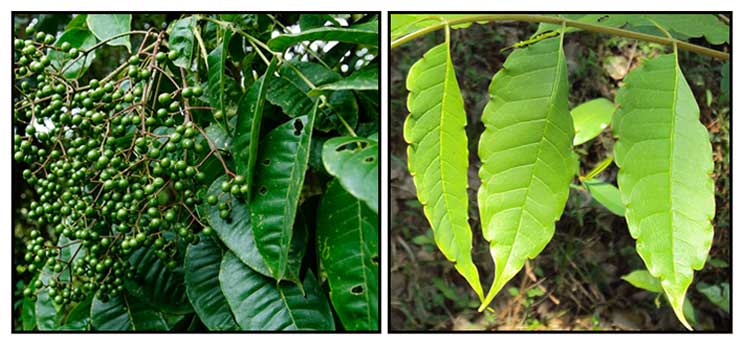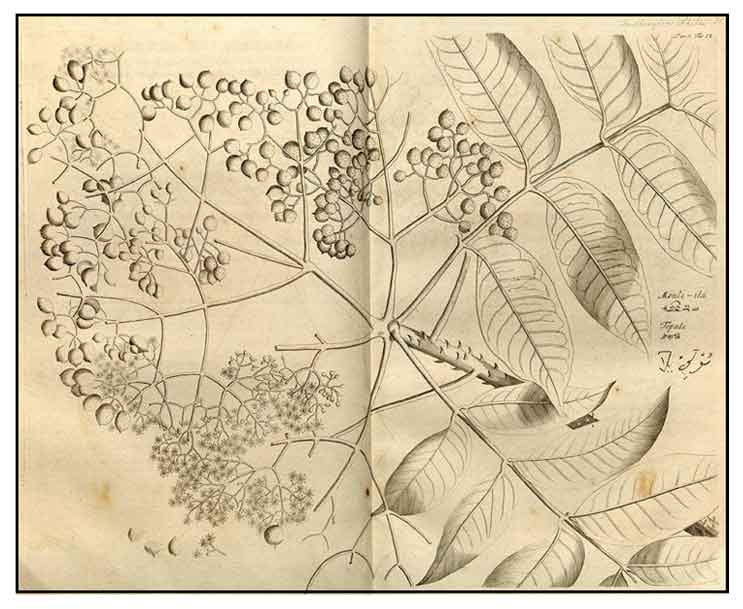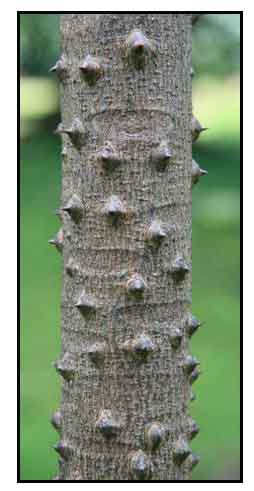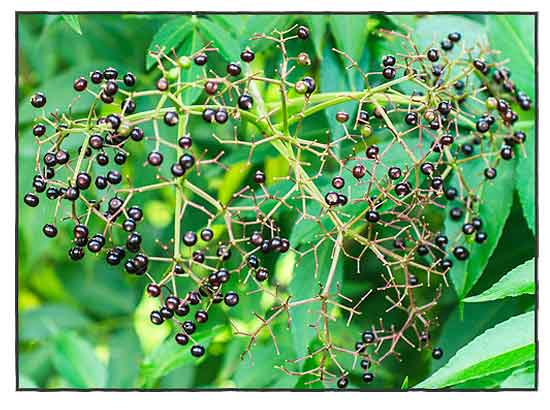
Gen info
- Zanthoxylum rhetsa is a species of flowering plant in the family Rutaceae.
- Indian prickly ash was first described in 1820 by William Roxburg who named it Fagara rhetsa in his book Flora Indica. In 1824, de Candolle changed it to Zanthoxylum rhetsa in his book Prodromus Systematis Naturalix Regni Vegetabilis. (41)
Botany
Kayetana is a small or medium-sized tree reaching a height of 20 meters. Branchlets are usually spineless. Bark has prominent conical spines. Leaves are pinnately compound, up to 35 centimeters or more in length, with 8 to 20 pairs of leaflets which are somewhat ovate, 5 to 12 centimeters long, with two sides very unequal, particularly at the base, with a tapering, pointed tip. Flowers are numerous, fairly small, yellowish-white, with a red center, 4-parted, and borne in considerable number on terminal panicles which are about 40 centimeters long. Fruit is solitary, 6 to 8 millimeters in diameter, finely tubercled, and red when ripe. Seeds are somewhat rounded, and bluish-black.
 Distribution Distribution
- In thickets and forests at low and medium altitudes, from northern Luzon (Cagayan) to Palawan and Mindanao.
- Also reported from India and Sri Lanka to Myanmar, Indo-China, Thailand, Peninsular Malaysia, Java, Moluccas, Sulawesi, and southern Papua New Guinea.
Constituents
- Fruit with peel yields volatile oil, 5.8 % with 90% terpenene (sabinene).
- Seeds contain 29.7 % volatile oil.
- Screening of an ethanolic extract of fruit for secondary metabolites yielded 8 glycosides, 10 flavonoids, 6 essential oils, 5 anthraquinones, 9 bitter principles, 7 coumarins, and 8 terpenoids.
(5)
- Preliminary screening of ethanol extracts of spine yielded alkaloid, terpenoid, catechin, coumarin, tannin, flavonoid, phenol, xanthoprotein, sugar, and fixed oil.
(10)
- The ash values of stem spine of Z. rhetsa is 4.42%; ash value is indicative of the impurities present in the drug. (10)
- Phytochemical screening of methanol extract of leaves yielded flavanoids, glycosides, tannins,saponins, terpenes, steroids, and anthocyanins.
(see study below) (11)
- Essential oil of pericarp yielded terpinen-4-ol (25.43%), sabinene (16.50%), β-pinene (10.4%), α-Terpineol (7.63%), γ-Terpinene (5.64%), α-pinene (4.33%), and linalool (3.25%). (see study below) (20)
 - Study of seed fatty acid content and fixed oil composition showed 19.5% crude fixed oil on DW basis. Ten fatty acids were identified; the major monounsaturated and saturated fatty acids were oleic acid (41.6-43.5%) and palmitic acid (26.8-30.2%) respectively, while polyunsaturated fatty acids were α-linolenic acid (12.1-12.5%) and linoleic acid (10.0%). Also identified were stearic acid (5.2-6.0%), myristic acid (0.1%), and traces of pentadecanoic, heptadecanoic and arachidic acid. (see study below) (21) - Study of seed fatty acid content and fixed oil composition showed 19.5% crude fixed oil on DW basis. Ten fatty acids were identified; the major monounsaturated and saturated fatty acids were oleic acid (41.6-43.5%) and palmitic acid (26.8-30.2%) respectively, while polyunsaturated fatty acids were α-linolenic acid (12.1-12.5%) and linoleic acid (10.0%). Also identified were stearic acid (5.2-6.0%), myristic acid (0.1%), and traces of pentadecanoic, heptadecanoic and arachidic acid. (see study below) (21)
- Phytochemical screening of leaf extract yielded flavonoids, terpenoids, and tannins. (see study below) (23)
- Study of volatile oil of seed coat yielded 34 compounds. The major compounds were terpinen-4-ol (32.1%), α-terpineol (8.2%), sabinene (8.1%), β-phellandrene (7.4%) and 2-undecanone (7.1%).
(24)
- GC-MS analysis of ethanolic extract of Z. rhetsa yielded 15 compounds. 1.2-Benzenedicarboxylic acid, diisooctylester (91.55%) was the major component followed by oleic acid (2.83%), and n-hexadecanoic acid (2.02%). (see study below) (2)
- Phytochemical analysis of stems yielded
flavonoids, glycosides, alkaloids, aleurone, starch, amino acids, lignin, volatile oil, fats and fixed oils, mucilage, pectins, proteins steroids, and terpenoids. (see study below) (27)
- Study of methanol extract of shoots for total phenolic and total flavonoid content yielded 117.95 ± 3.22 mg GAE/g and 120.13 ± 2.31 µMRE/g, respectively. (see study below) (28)
- Study reported on the isolated of alkaloids evodiamine and aquartenary alkaloid hydroxyevodiamine from the bark of Z. rhetsa. (32)
- Proximate analysis of unripened and ripened fruits yielded: moisture
46.8 ± 0.32% vs 49.2 ± 0.35%, dry content 53.2 ± 0.32 / 50.8 ± 0.35%, ash 4.0 ± 0.10 / 3.5 ± 0.36%, crude fiber 6.5 ± 0.51 / 4.8 ± 0.30%, crude fat 3.5 ± 0.4 / 4.0 ± o.50%, crude protein 3.6 ± 0.97 / 1.0 ± 0.45%, reducing sugar 0.15 ± 0.07 / 0.23 ± 0.04%, total sugar 0.25 ± 0.06 / 0.3 ± 0.2%, starch 1.5 ± 0.25 g / 1.02 ± 0.05 g, carbohydrate 1.75 ± 0.07 / 1.32 ± 0.04 g, energy content 158.9 ± 13.31 / 172.4 ± 22.68 KJ/100g, respectively. (35)
- Mineral analysis of ripened and unripened fruit (mg/100g) yielded nitrogen 220-160, phosphorus 50-100, potassium 310-330, calcium 430-1000, magnesium 950-1001, sulphur 250-100, sodium 820-860, zinc 1.99-2.0, ferrous 2.14-2.2, copper 0.86-1.2 and manganese 2.9-3.1, respectively. (35)
- Phytochemical analysis of various bark extracts yielded alkaloids, tannins, flavonoids, phenolic compounds, steroids. (see study below) (36)
- Study for essential oils yielded major components of sabinene (22.51%) and terpinene-4-ol (32.33%).
(see study below) (37)
- GC-MS Thai study of 10 samples of Z. rhetsa fruits and seeds
showed major constituents of sabinene (56.62%), 4-terpinol (13.82%), germacrene (10.1%), gramma-terpinene (5.5%), and alpha-terpinene (3.5%). (38)
 Properties Properties
- Fruit is considered stimulant, astringent, aromatic, digestive.
- Bark considered aromatic and aphrodisiac.
- Essential oil from fruits a locally anesthetic.
- Studies have shown analgesic, antidiarrheal, antidiabetic, antiparasitic, anticestodal, antidiarrheal, antispasmodic, anti-inflammatory, diuretic, hemostatic, hypoglycemic, piscicidal, photoprotective, hypolipidemic, anticestodal, wound healing, antibacterial, anticancer, anthelmintic, photoprotective, antinociceptive properties.
Parts used
Bark, roots, fruit.
Uses
Edibility
- Bark and immature fruits used as spice.
-
Bark has a lime-pepper flavor. Cooked in syrup with other spices and made into a relish. (26)
- Fruit has taste and aroma of orange peels. (26)
-
Seeds used as substitute for black pepper. (26)
- Fruits and tender leaves eaten cooked.
(26)
- In India, the indigenous people of Arunachal Pradesh use tender shoot as hot spice for the characteristic aroma and burning sensation it imparts. (28)
- The people of Goa, Konkan, the Kanara coasts
, and Coorg use the woody pericarp of tiny fruits as spice. It is known as "triphal" in Marathi, "teppal" in Konkani, both names referring to the three lobes of the pericarp. The spice contains sanshool, a chemical ingredient with anesthetic effect that causes tingling sensation of the tongue. Sanshool is the main ingredient of Sichuan pepper. (41)
Folkloric
- Bark, pounded and mixed with oil, used externally as remedy for stomach pains.
- Decoction of bark taken internally for chest pains.
- Bark chewed and applied to snake bites.
- Fruit used for urinary complaints and dyspepsia caused by atrabilis (the melancholic "humor"). Also used in some forms of diarrhea.
- Bark is considered a bitter aromatic and aphrodisiac.
- Fruit, mixed with honey, taken for rheumatism.
- In Goa, root bark used as purgative for kidneys.
- Essential oil used for cholera. Also used as antiseptic or disinfectant. (26)
- Plant used by Aka tribes of Arunachal Pradesh, India, for diarrhea. Also used as anti-inflammatory and fish poisoning.
For labor pains and after delivery, dry fruits and fried in a hot plate and taken with warmed Tsii (locally made rice beer). (15)
- Adi tribes of lower Digang Valley of Arunachal Pradesh, India, use boiled or steam leaves for the treatment of warts and jaundice. (16)
- In India, traditionally used in diabetes and inflammation; as antispasmodic, diuretic and anti-inflammatory.
- In Tamil Nadu, India, plant used to increase lactation in nursing mothers. (2)
- Naga tribes of India use the plant as deworming remedy.
- The Kanikkar tribe in Tamil Nadu prepare a paste of the plant by rubbing the hard spines on rock along with water and apply it on the breast for relief of pain and to increase lactation in nursing mothers. (10)
- Paste prepared by rubbing the hard spines on rock and water is applied to breasts to relieve pain and increase lactation in nursing mothers.
Others
- Leaves used like hops when brewing rice beer. (26)
Studies
• Antiparasitism: Study investigated the efficacy of Z. rhetsa leaf extract against experimental Hymenolepsis diminuta infections in albino rats. The efficacy of the extract was moderate against immature and adult stages of parasite. Results suggest the leaves of ZR possess significant anticestodal property and supports its use in folk medicine. (1)
• Bark Constituents: Study yielded 15 compounds. dodecanoic acid, 9,12,octadecanoic acid, oleic acid, octadecanoic acid, 2-hydoxyl-1,3-propanediyl ester, and 1,2-benzenedicarboxylic acid, diisooctylester--phytochemicals that showed various properties: antioxidant, antimicrobial, larvicidal, anti-inflammatory and anti-arthritic. (see constituents above) (2)
• Essential Oil / Antibacterial: Essential oil steam distilled from aqueous, alkaline, and acidic media showed significant antibacterial activity against S. aureus, E. coli, P. vulgaris and K. pneumonia probably due to synergistic effect of the components present in the oil. The acid distilled essential oil can be used as a potential external antiseptic and incorporated into drug formulations. (3)
• Secondary Metabolites: An ethanolic extract of fruit yielded 8 glycosides, 10 flavonoids, 6 essential oils, 5 anthraquinones, 9 bitter principles, 7 coumarins, and 8 terpenoids. (5)
• Antinociceptive / Anti-Diarrheal: A methanol extract of stem bark significantly reduced abdominal contraction induced by acetic acid and diarrheal episodes induced by castor oil in mice. (7)
• Anticestodal / Anti-Diarrheal: A leaf extract was investigated against experimental Hymenolepis diminuta (Cestoda) infections in albino rats. The extract exhibited moderate efficacy against immature and adult stages of the parasite. The anticestodal property supports its use in folk medicine. (8)
• Sunscreen Activity / Seed: Study evaluated the formulation of a sunscreen lotion using a methanolic extract of ZR seed. Evaluation of sunscreen activity using in vitro SPF method showed the formulation to be 1.09 with an ultra boot star rating 2 which approaches toward sunscreen activity. (9)
• Pharmacogonostical Study of Spine: Study attempts a modest comprehensive investigation of the stem spines of Zanthoxylum rhetsa. Various extracts of stem spines yielded alkaloid, catechin, coumarin, flavonoid, phenol, quinone, steroid, tannin terpenoid, sugar, glycoside, xanthoprotein, and fixed oil. Ash value is 4.41%—ash value are constant for a given drug, and generally the index of purity as well as identity of the drug. The pharmacognostic studies include microscopic, physicochemical constants (ash & extractive values), fluorescence analysis and preliminary phytochemical evaluations. (10)
• Antidiabetic / Leaves: Study evaluated the hypoglycemic effects of an aqueous methanolic extract of Zanthoxylum rhetsa leaves. Phytochemical screening yielded flavanoids, glycosides, tannins, saponins, terpenes, steroids, and anthocyanins.
(see study below). Study suggests a vital role for Z. rhetsa leaves in diabetic healing. (11)
• Anti-Inflammatory / Inhibition of LPS-Induced COX-2 and iNOS Expression: Study evaluated a methanol extract of ZR for its ability to suppress the formation of inducible nitric oxide synthase (iNOS) and cycloxygenase-2 (COX-2) in LPS-activated RAW 264.7 macrophages. The production of tumor necrosis factor-α (TNF-α), the mRNA expression of pro-inflammatory cytokines, including TNF-α and IL-1ß, were dose dependently reduced by MZRR extract. Results suggest the extract's involvement in the inhibition of iNOS and COX-3 via the NF-kB pathway, a partial molecular basis for its anti-inflammatory effect. (12)
• Antibacterial / Stem and Roots: Study evaluated the antibacterial properties of root, stem, and bark of Zanthoxylum rhetsa. Alcoholic and acetone extracts of bark and stem showed antibacterial properties against Pseudomonas aeruginosa, Staphylococcus aureus, Salmonella typhimurium, Bacillus megaterium and Escherichia coli. Roots showed less antibacterial properties than bark and stem. (13)
• Antioxidant / Aerial Parts: Study investigated the in vitro antioxidant activity of Z. rhetsa by DPPH and ABTS radical scavenging methods. Ethyl acetate, methanol, and water extracts showed significant DPPH and ABTS free radical scavenging activity. Methanol extract showed the highest amount of phenolic and flavonoid contents. (14)
• Haemostatic Activity: Indian herbs have been traditionally used for wound healing and controlling hemorrhage from cuts and bruises. In a screening study of ten Indian medicinal plants, a petroleum ether extract was one of the the plants that showed haemostatic activity. (19)
• Antinociceptive / Antioxidant / Seeds : Study evaluated the antinociceptive and antioxidant potential o an ethanol extract of Z. budrunga seeds. In hot-plate test, ZB seed extract raise the pain threshold significantly. In DPPH scavenging assay, IC50 was observed at 82.60 µg/mL. Phenolic content was 338.77 mg GAE/100g of dried plant material. Caffeic acid and other phenolics may play a role in the observed activity. (18)
• Antidiarrheal / Antispasmolytic / Pericarp Essential Oil : Study of essential oil, its fractions and terpinen-4-ol exhibited appreciable antioxidant, antibacterial, antidiarrheal and non-selective spasmolytic activity. The active component terpinen-4-ol has a high potential in the treatment of stress and gastrointestinal diseases. (see constituents above) (20)
• Seed Oil Composition / Radical Scavenging Activity / Inhibition of GI Motility: Study evaluated seed fatty acid content and fixed oil composition. Fixed oil exhibited significant free radical scavenging activity and significant inhibition of gastrointestinal motility. (see constituents above) (21)
• Antihyperglycemic / Antihyperlipidemic / Antioxidant: Study of methanolic and aqueous extracts of Z. rhetsa bark in streptozotocin induced diabetic rats showed potent antihyperglycemic, antihyperlipidemic and antioxidant activity. (22)
• Thrombolytic / Leaves: Study evaluated the thrombolytic activity of a methanolic extract of Z. rhetsa leaves. Results showed significant thrombolytic activity 25.23 ±0.04% compared with maximum effect of Streptokinase 66.978 ±0.11. (23)
• Anthelmintic / Leaves / Fruits: Studies on leaf extract have shown a high degree of efficacy against larval stage in H. diminuta rat model and moderate level of efficacy against immature and adult stages of tapeworm. (25) Study evaluated the in vitro anthelmintic activity of total methanol extracts and solvent fractions of of leaves and fruits on Eisenia fetida and Tubifex tubifex. The leaf and fruit extracts showed presence of alkaloids, flavonoids, terpenoids, coumarins, essential oils, and saponins. The extracts showed significant significant anthelmintic activity as evidenced by decrease in paralysis death time in the treatment groups. (44)
• Anti-Inflammatory / Stem: Study of shade-dried Z. rhetsa stem extracts by protein denaturation and HRBC method showed significant anti-inflammatory activity. Denaturation of protein is a well documented cause of inflammation and rheumatoid arthritis. (see constituents above) (27)
• Antioxidant / Shoots / Aerial Parts: Study evaluated a methanolic extract of shoots of Z. rhetsa for total flavonoid and total phenolic content and antioxidant activity. Results showed antioxidant potential by DPPH and ABTS assays with IC50 of 306 ± 4.21 µg/ml and 271 ± 3.5 µg/ml, respectively. Study showed not significant correlation between total phenolic, total flavonoid, and antioxidant activity. (see study above) (28) Study evaluated various extracts of Z. rhetsa aerial parts for antioxidant activity. Ethyl acetate, methanol, and water extracts showed significant DPPH and ABTS free radical scavenging activity. Reducing power was maximal in the methanol extract. (29)
• Cytotoxicity Against B16-F10 Melanoma Cancer / Bark: GC-MS analysis of bark of Z. rhetsa identified major volatile constituents and isolated two tetrahydrofuran lignans (yangambin and kobusin), a berberine alkaloid (columbamine) and a triterpenoid (lupeol) from the chloroform fraction. All solvent fractions and purified compounds were non-cytotoxic to HDF (human dermal fibroblasts). However, the chloroform fraction and kobusin showed cytotoxic effect against B16-F10 melanoma cells. The activity was attributed to bioactive lignans and alkaloids. (30)
• Effect on Hyperglycemia and Hyperlipidemia /
Bark: Study evaluated the antihyperglycemic, antihyperlipidemic, and antioxidant effect of methanolic and aqueous extracts of ZR bark in normal and STZ-induced diabetic rats. Results showed significant hypoglycemic effect and reduction in lipid parameters along with marked rise in HDL-C level. There was also relevant antioxidant activity. (31)
• Photoprotective /
Sunscreen and Anti-Ageing Potential / Bark: Study reports on the photoprotective potential of Z. rhetsa. An ethyl acetate fraction showed the highest sunscreen protection factor (SPF) value. All fractions exhibited broad UV spectrum absorption for both UVB and UVA regions. The EA fraction showed highest activity by DPPH and NO free radical scavenging assay. Results suggest the ZR bark extract has great potential as natural ingredient in broad spectrum sunscreen and anti-ageing cosmetic products. (33)
• Piscicidal Effect / Seeds: Study evaluated the toxic effect of Z. rhetsa seed extracts of stinging catfish, Heteropneustes fossilis. Results showed Z. rhetsa has potential pisicidal effect on fish and can be used widely to control unwanted fishes. (34)
• Alpha-Amylase Inhibition / Potential Hypoglycemic / Bark: Study evaluated various extracts of Z. rhetsa for hypoglycemic effects via in-vitro α-amylase inhibition. Results showed significant percentage inhibition of +5.67. Isolate from the methanolic extract yielded a flavonoidal moiety. (see constituents above) (36)
• Antibacterial / Antioxidant / Anticancer / Essential Oil: GC-MS study for essential oils yielded major components of sabinene (22.51%) and terpinene-4-ol (32.33%).
The EO from Z. rhetza exhibited moderate antioxidant activity by DPPH and ABTS methods. Z. rhetza EO exhibited inhibitory activity against breast cancer cell (MCF-7 and MDA-MB-231) proliferation and cell viability. (37)
• Anti-Inflammatory / Seed and Pericarp: Study evaluated the anti-inflammatory activity of various extracts of various parts of Z. rhetsa via inhibition of inflammatory mediators (NO, TNF-α, and PGE2) in RAW264.7 macrophages. The pericarp hexane (PH) and 95% ethanolic extract (P95) and seed essential oil were the most active extracts. PH and P95 exhibited highest inhibition of NO production with IC50s of 11.99 and 15.33 µg/ml, respectively, and also exhibited highest anti-inflammatory effect on TNF-α with IC50s of 36.08 and 34.90 µg/ml, respectively, and also highest PGE2 inhibitory effect. 2,3-Pinanediol was the major anti-inflammatory compound in PH (11.28%) and P905 (19.82%), while terpinen-4-ol was the major compound in seed essential oil at 35.13%. (39)
• Silver Nanoparticlesv/ Anticancer / Antibacterial / Seed Coat: Study reports on the eco-friendly, cost-effective, and green synthesis of AgNPs using Z. rhetsa seed coat extract. The AgNPs showed antibacterial activity against four pathogenic bacteria tested viz. E. coli, S. aureus, S. pneumonia, and E. faecalis. MTT assay showed the AgNPS have good anticancer activity against A549 lung cancer cell line. (40)
• Wound Healing / Stem: Study evaluated the wound healing properties of aqueous extract of Z. rhetsa stems using a topical formulation in an excision wound model on Wistar rats for 21 days. Providone iodine ointment was used as standard. AQZR exhibited similar in vivo wound healing activity as the standard but with lesser magnitude. Activity was attributed to flavonoid and phenolic contents. (42)
• Cytotoxic Effects in Cervical Cancer Cells / Oil: Study evaluated the cytotoxic effects of Z. rhetsa oil in cervical cancer cells. GC-MS analysis identified 28 known compounds, including monoterpenes, sesquiterpenes and hydrocarbon. The oil inhibited HeLa cell proliferation with low IC50 and decreased colony formation. The oil induced early apoptotic cell death with a higher percentage at 250 µg/mL. The oil stimulated anti-migratory activities of the cervical HeLa. Results demonstrated the oil induced cancer cell death, activated early apoptosis, and suppressed migration ability of cervical cancer cells by stimulating ROS formation. (43)
• Antileukemic / Cytotoxic and Apoptosis via Intrinsic Pathway in Jurkat Cells / Leaves: Study evaluated the antileukemic potential of leaf extract of Z. rhetsa and probably mechanism of cytotoxicity. Antiproliferative activity of the extract on leukemic cells was evaluated using sulforhodamine B assay. The extract showed concentration-dependent cytotoxicity against Jurkat cell lines mainly via apoptotic mechanism. It arrested cells at G0/G1 and S phase of cell cycle. Apoptosis was associated with increase in expression of pro-apoptotic markers and decrease of anti-apoptotic markers. Treatment selectively increased oxidative stress in Jurkat cells and showed DNA fragmentation. Results showed selective cytotoxic activity on Jurkat cell lines and apoptosis induction via intrinsic pathway. (45)
Availability
- Wild-crafted.
- Seeds and essential oil in the cybermarket. |

![]()




 Distribution
Distribution - Study of seed fatty acid content and fixed oil composition showed 19.5% crude fixed oil on DW basis. Ten fatty acids were identified; the major monounsaturated and saturated fatty acids were oleic acid (41.6-43.5%) and palmitic acid (26.8-30.2%) respectively, while polyunsaturated fatty acids were α-linolenic acid (12.1-12.5%) and linoleic acid (10.0%). Also identified were stearic acid (5.2-6.0%), myristic acid (0.1%), and traces of pentadecanoic, heptadecanoic and arachidic acid. (see study below) (
- Study of seed fatty acid content and fixed oil composition showed 19.5% crude fixed oil on DW basis. Ten fatty acids were identified; the major monounsaturated and saturated fatty acids were oleic acid (41.6-43.5%) and palmitic acid (26.8-30.2%) respectively, while polyunsaturated fatty acids were α-linolenic acid (12.1-12.5%) and linoleic acid (10.0%). Also identified were stearic acid (5.2-6.0%), myristic acid (0.1%), and traces of pentadecanoic, heptadecanoic and arachidic acid. (see study below) (
